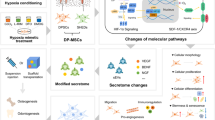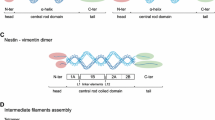Abstract
Background
Undifferentiated human dental cells and especially human dental follicle cells are interesting for potential dental treatments. These somatic stem cells are cultured usually in cell culture medium containing bovine serum. In the age of bovine spongiform encephalopathy (BSE), a serum-free cell culture system for dental follicle cells are recommended, if these cells will be applied in dentistry.
Purpose
However, less is known about the cultivation of dental follicle cells in serum-replacement medium. In this study, we cultivated dental follicle cells in serum-free cell culture medium, which is normally applied for neuronal stem/progenitor cells.
Materials and methods
Dental follicle cells were cultivated in both serum-free and serum-containing cell culture media, and gene expression profiles were recorded for connective tissue markers collagen type I and type III and for the human dental follicle cell marker nestin.
Results
It is interesting to note that the gene expressions of collagens and nestin were similar after applying both cell culture conditions.
Conclusion
Although the gene expression of dental follicle cell markers was unchanged, a more appropriate serum-free cell culture medium is recommended for cell proliferation of dental follicle cells.


Similar content being viewed by others
References
El Nesr NM, Avery JK (2002) Development of the teeth:root and supporting structures. In: Avery JK, Steele PF, Avery N (eds) Oral development and histology. 3rd edn. Thieme, New York, pp 108–122
Engelhardt M, Wachs FP, Couillard-Despres S, Aigner L (2004) The neurogenic competence of progenitors from the postnatal rat retina in vitro. Exp Eye Res 78:1025–1036
Gronthos S, Mankani M, Brahim J, Robey PG, Shi S (2000) Postnatal human dental pulp stem cells (DPSCs) in vitro and in vivo. Proc Natl Acad Sci U S A 97:13625–13630
Miura M, Gronthos S, Zhao M, Lu B, Fisher LW, Robey PG, Shi S (2003) SHED: stem cells from human exfoliated deciduous teeth. Proc Natl Acad Sci U S A 100:5807–5812
Morsczeck C, Gotz W, Schierholz J, Zeilhofer F, Kuhn U, Moehl C, Sippel C, Hoffmann KH (2005) Isolation of precursor cells (PCs) from human dental follicle of wisdom teeth. Matrix Biol 24:155–165
Morsczeck C, Moehl C, Gotz W, Heredia A, Schaffer TE, Eckstein N, Sippel C, Hoffmann KH (2005) Differentiation in vitro of human dental follicle cells with dexamethasone and insulin. Cell Biol Int 29:567–575
Ten Cate AR (1997) The development of the periodontium—a largely ectomesenchymally derived unit. Periodontol 2000 13:9–19
Thesleff I, Mikkola M (2002) The role of growth factors in tooth development. Int Rev Cytol 217:93–135
Winer J, Jung CK, Shackel I, Williams PM (1999) Development and validation of real-time quantitative reverse transcriptase-polymerase chain reaction for monitoring gene expression in cardiac myocytes in vitro. Anal Biochem 270:41e9
Wise GE, Frazier-Bowers S, D_Souza RN (2002) Cellular, molecular, and genetic determinants of tooth eruption. Crit Rev Oral Biol Med 13:323–334
Wise GE, Yao S (2006) Regional differences of expression of bone morphogenetic protein-2 and RANKL in the rat dental follicle. Eur J Oral Sci 114:512–516
Yao S, Norton J, Wise GE (2004) Stability of cultured dental follicle cells. Cell Prolif 37:247–254
Zhao M, Xiao G, Berry JE, Franceschi RT, Reddi A, Somerman MJ (2002) Bone morphogenetic protein 2 induces dental follicle cells to differentiate toward a cementoblast/osteoblast phenotype. J Bone Miner Res 17:1441–1451
Author information
Authors and Affiliations
Corresponding author
Rights and permissions
About this article
Cite this article
Morsczeck, C., Ernst, W., Florian, C. et al. Gene expression of nestin, collagen type I and type III in human dental follicle cells after cultivation in serum-free medium. Oral Maxillofac Surg 12, 89–92 (2008). https://doi.org/10.1007/s10006-008-0111-y
Received:
Accepted:
Published:
Issue Date:
DOI: https://doi.org/10.1007/s10006-008-0111-y




